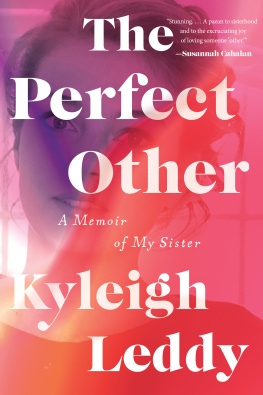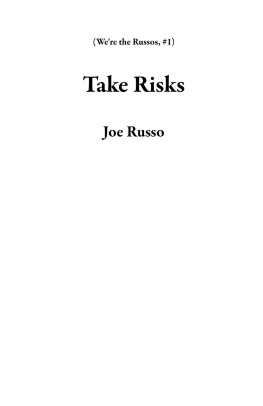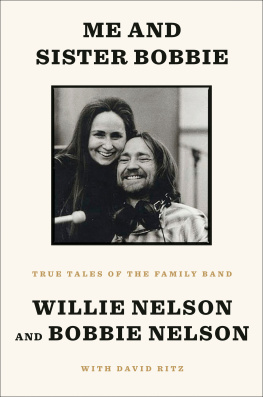This book is for the estimated 970 million people worldwide who suffer from a mental health disorder. This book is for their suffering, and for those who love them.
All I can hope is that it helps, even just a single person, even just for a moment.
While writing this book, I kept returning to the part of the Hippocratic Oath that instructs, Do no harm. My intention was genuine and transparentI wanted to help break the stigma surrounding mental illness and assist others in all the ways that I failed to save my sister. There was also, in all honesty, a quality of penance to the undertaking as well, as if by seeking to prevent future tragedies, my guilt over the past could be lessened.
The opportunity to share my familys story fell into place in a way that I can only describe as divine luck. The unlikely events aligned like a string of runway lights, setting the way forward, and for the first time in my overly anxious, constantly second-guessing mind, the path before me was undeniable. Every morning I woke with a burning urge to get the words down on paper, and every night before bed, I was kept awake with the fear that I wouldnt have the chance to finish or remedy it. I took to sending my most recent draft to my email, writing down my password, and reminding my mom to forward it to my editor if something should happen to me. I was almost scary in my single-minded, ceaseless determination, possessed by my mission to an unhealthy degree. After years of uselessly standing by as my sisters battle with her mental health spiraled to new lows, I finally had a chance to do something, to help. The effect was dizzying.
Then, inevitably, once the first draft was committed to the page, this conviction shook loose. Part of my fear was born as a natural extension of the subject I chose to write about: Mental health is complicated and inherently personal. No single experience is exactly the same, and while there is power in relating to an individual perspective, there is also a great deal of danger. After all, how can one person, from a comparatively privileged subset of our population, speak for a world of diverse experiences?
The answer is she cant.
It is important to acknowledge that the story you are about to read centers around a girl who, despite her mental illness and according to the many problematic standards of our society, was immensely privileged: She was white, heterosexual, cisgender, physically attractive, smart, capable, and fiercely loved. She attended a well-funded school district, had a family that was eager to help her in any way they could, and had safety nets in place that kept her from falling into homelessness or prison. She possessed the financial luxury to attend rehabilitation centers, therapy, experimental treatments, and group homes, and the healthcare coverage to be prescribed antipsychotic medication. She was an anomaly, the peak of fortune, and yet none of this was enough to save her.
According to the United States HHS Office of Minority Health, Black Americans are more likely to report persistent symptoms of emotional distress than white Americans, but only one in three Black adults who need mental healthcare receive it. There are countless systemic reasons why this is true: intergenerational trauma, higher rates of cyclical poverty, and limitations in access to healthcare resources. There is the nature of the prison industrial system, microaggressions, the stress and physical trauma of racism, the lack of diversity in mental healthcare providers, and many, many more tragic factors.
There is also an incredible burden on the LGBTQ community: higher rates of trauma, hate crimes, bullying, depression, anxiety, and substance abuse. According to the CDC, queer youth are twice as likely to attempt suicide as their heterosexual peers are.
In 2018, 19.1 percent of the United States reported a mental illness (this is 47.6 million people, or one in five adults). Of these cases, schizophrenia is purported to affect 1.5 million U.S. citizens. Furthermore, 37 percent of incarcerated adults and 20.1 percent of individuals experiencing homelessness have been diagnosed with a mental illness. In the United States, suicide is the second leading cause of death for people ages ten to thirty-four, and depression is the leading disability worldwide. The weight of knowing I will doubtlessly fail to capture and recognize these innumerable experiences left me frequently paralyzed.
It is also worth mentioning that diagnosis isnt a straight lineits possible for a treatment to be worse than the ailment itself, or for that very same ailment to be an unlikely source of enjoyment. For my sister, the diseases progression was a deterioration, a lessening of who she was rather than a means by which she expanded. This is not the case for everyone, and I would hate if my sharing of my limited perspective, my very microscopic story in a universe of macrocosms, meant anyone else felt invalidated.
The Nigerian writer and public speaker Chimamanda Ngozi Adichie said it best: The single story creates stereotypes, and the problem with stereotypes is not that they are untrue, but that they are incomplete. They make one story become the only story. This book is a single rock in the void. We need more voices, more stories, and we need them now.
Rarely will you be the first in all of human history to experience anything, but you will experience it all your own just the same. I know there are thousands, millions, billions of stories that my own will never touch. I also know that somewhere out there is a family suffering as ours did, voiceless and afraid.
O n January 8, 2014, my sister, Kait, was wearing a red North Face jacket when she disappeared.
That is a fact among others. None of them makes much sense to me.
A girl walks to the peak of the Benjamin Franklin Bridge. A girl in a red North Face jacket and high winter boots. A girl walks, and then, poof, gone.
My sister walks to the peak of the Benjamin Franklin Bridge.
Kait walking.
Kait, and then, poof, gone.
I repeat this mantra in my head. When I say it aloud, the words solidify, become something permanent. When I write it, the block letters stare back at meformal and official like the autopsy report we never received.
My sister on the Benjamin Franklin Bridge.
On January 8, 2014, my sister walked the Benjamin Franklin Bridge.
My sister disappeared.
How? Why?
I never viewed the security photographs myself. I didnt ask to. Is it really her? Are we sure? Perhaps it was easier not to know, not to have the definitive proof of seeing it for myself. The image in my head is thus one of my own creation.
A girl walking.
Kait walking.
Poof, gone.
W hen I was twenty years old, I went to a psychic in lieu of going to a therapist.
The decision was made in a semi-desperate strait, the way I assume most people find themselves at an ostensible mystics door: half believing, half skeptical, morbidly curious, and almost always looking for some elusive answer that proved absent elsewhere.
I had worn down the alternative path already, tried on different therapists like Goldilocks, never finding one that fit just right. In the last few years, I sat before men and women, young and old, austere and analytical, flowery and bohemian. They always meant well, but it was as if they could taste my hunger in the air, my desperation to be pardoned and validated. My carnal need for an excuse vibrating between us. I sometimes wondered if they could see into my very brain. Could they tell that my nerves were all bundled and splintered, like necklaces tangled in the bottom of a drawer?







![Bartók Mira - The memory palace: [a memoir]](/uploads/posts/book/250588/thumbs/bart-k-mira-the-memory-palace-a-memoir.jpg)

